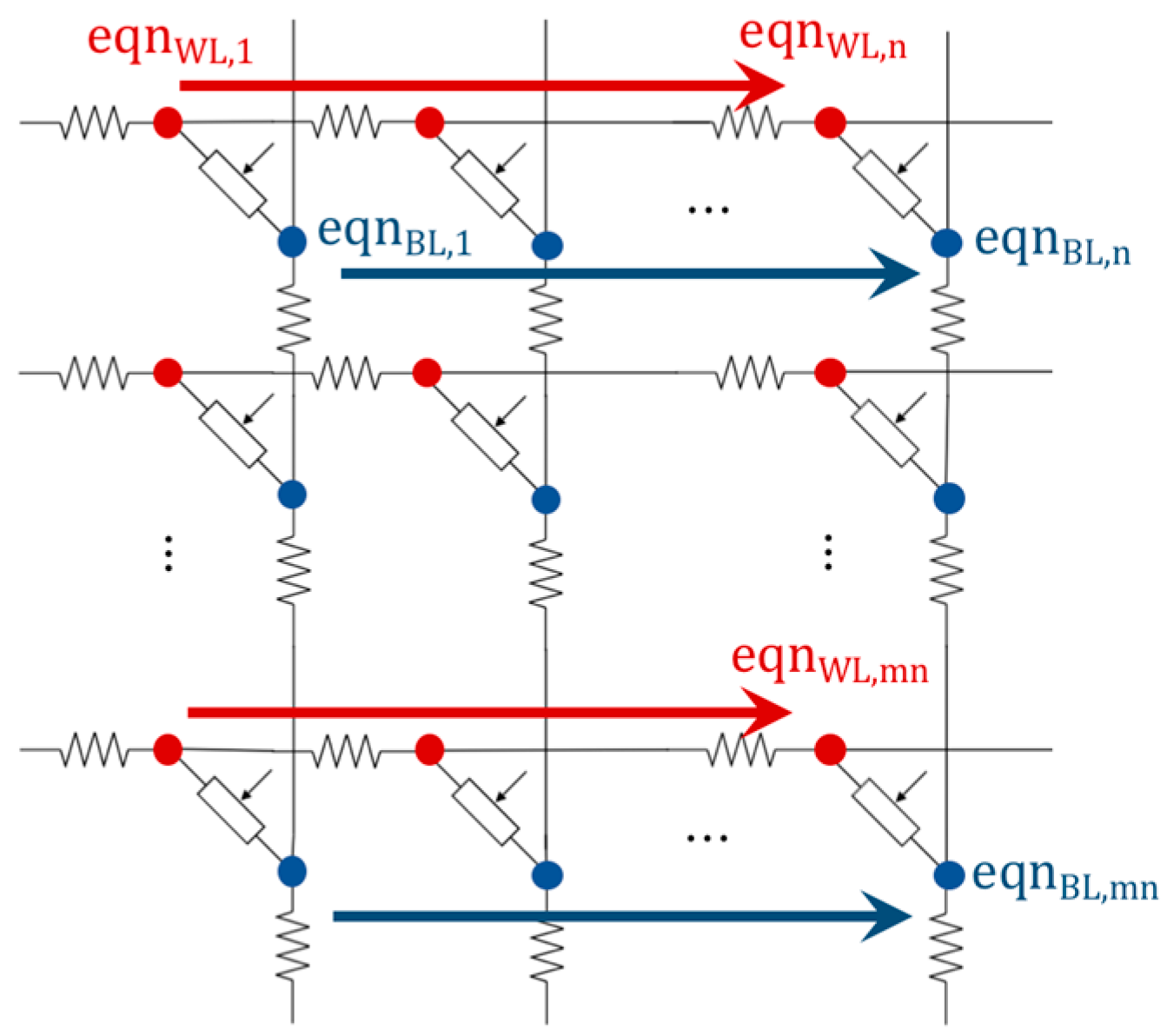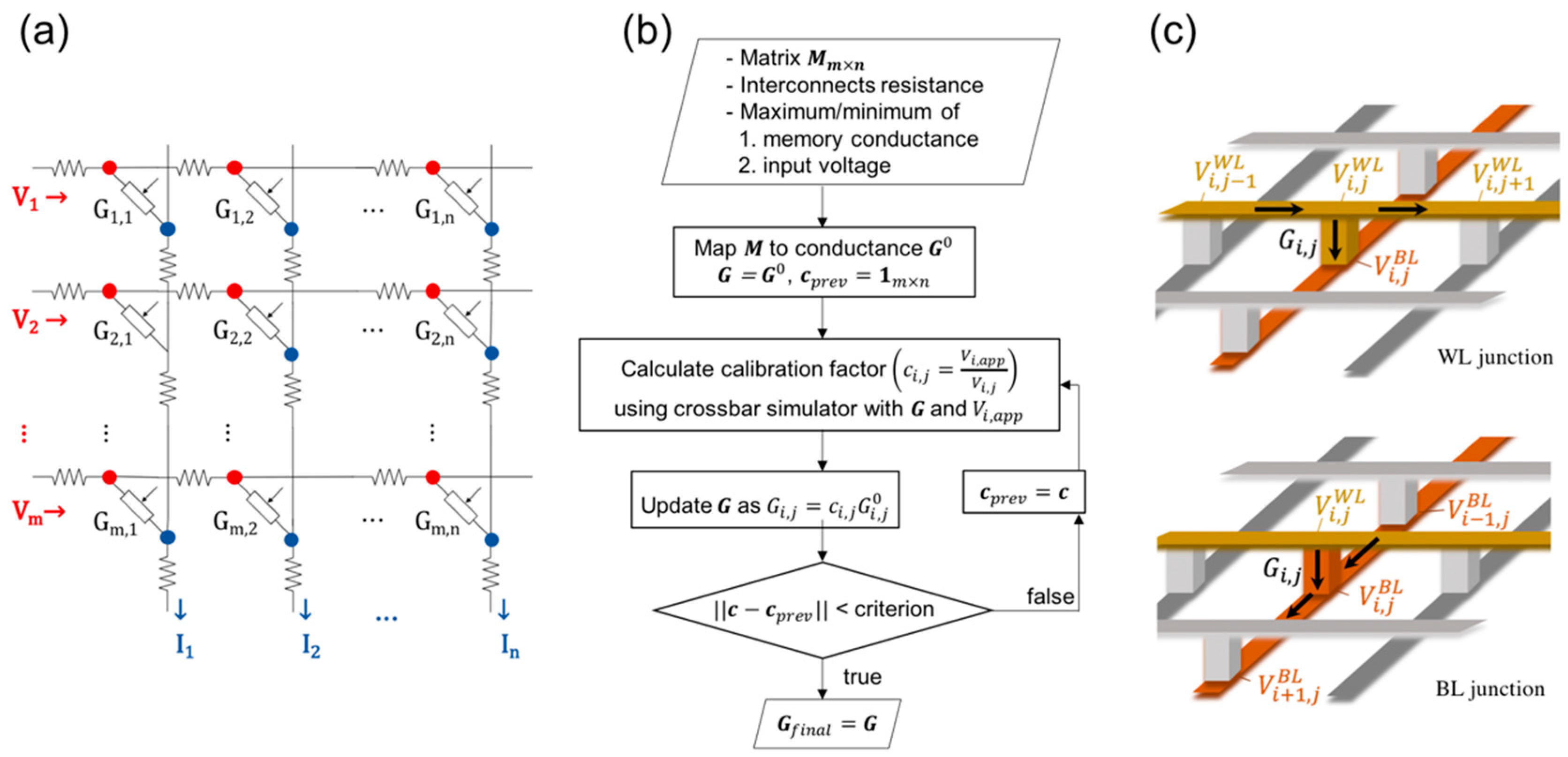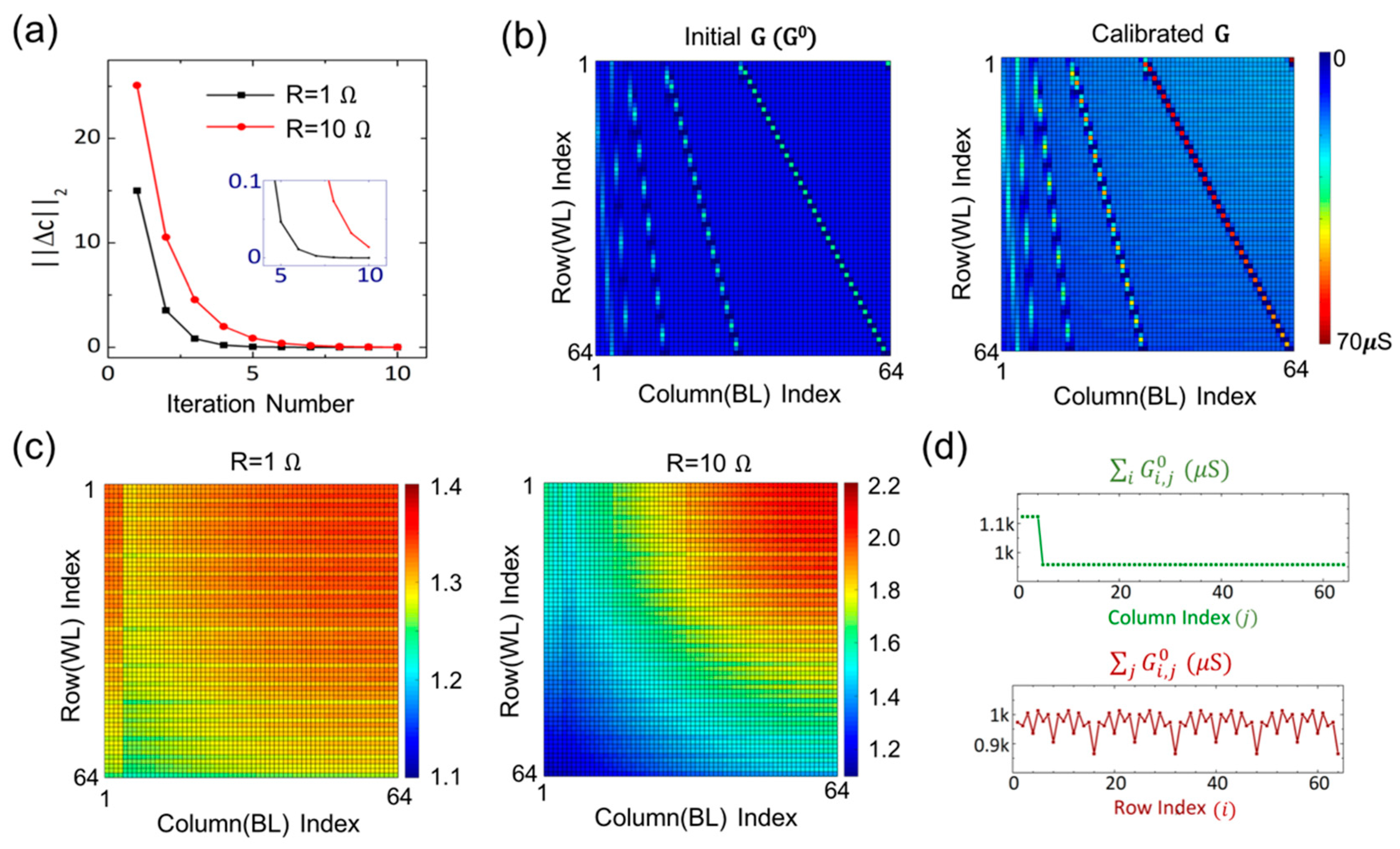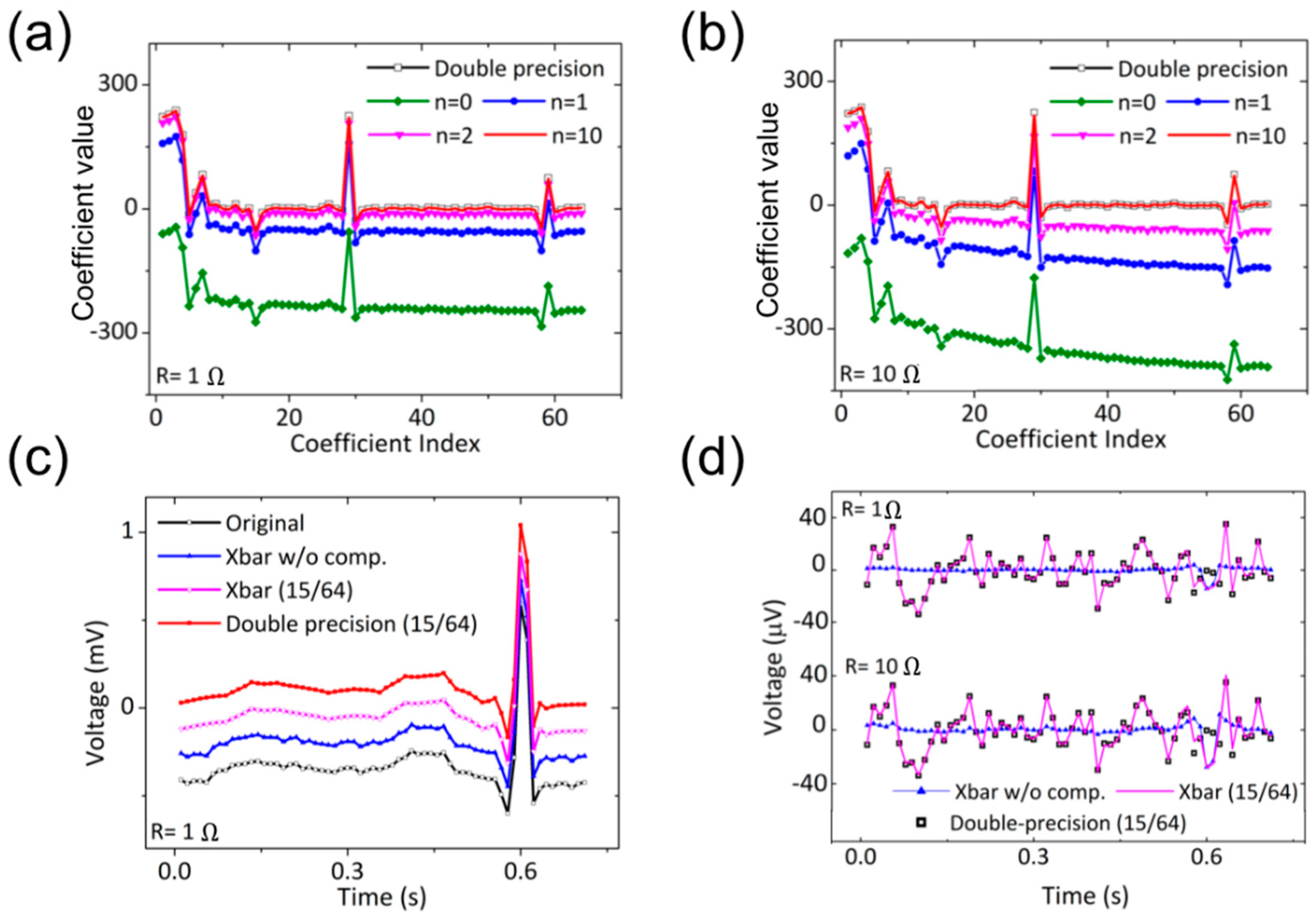Matrix Mapping on Crossbar Memory Arrays with Resistive Interconnects and Its Use in In-Memory Compression of Biosignals
Abstract
:1. Introduction
2. Methods
2.1. Calibration Factor for Matrix Mapping on Proposed Crossbar Model
2.2. Iterative Calibration Based on Crossbar Simulation
3. Results and Discussion
4. Conclusions
Author Contributions
Funding
Conflicts of Interest
Appendix A

References
- Li, C.; Hu, M.; Li, Y.; Jiang, H.; Ge, N.; Montgomery, E.; Zhang, J.; Song, W.; Dávila, N.; Graves, C.E.; et al. Analogue Signal and Image Processing with Large Memristor Crossbars. Nat. Electron. 2017, 1, 52. [Google Scholar] [CrossRef]
- Wright, C.D. Precise Computing with Imprecise Devices. Nat. Electron. 2018, 1, 212–213. [Google Scholar] [CrossRef]
- Hussein, A.F.; Hashim, S.J.; Aziz, A.F.A.; Rokhani, F.Z.; Adnan, W.A.W. A Real Time ECG Data Compression Scheme for Enhanced Bluetooth Low Energy ECG System Power Consumption. J. Ambient Intell. Humaniz. Comput. 2017. [Google Scholar] [CrossRef]
- Yu, B.; Yang, L.; Chong, C.C. ECG Monitoring over Bluetooth: Data Compression and Transmission. In Proceedings of the IEEE Wireless Communication and Networking Conference, Sydney, NSW, Australia, 18–21 April 2010; pp. 1–5. [Google Scholar]
- Gallo, M.; Sebastian, A.; Cherubini, G.; Giefers, H.; Eleftheriou, E. Compressed Sensing With Approximate Message Passing Using In-Memory Computing. IEEE Trans. Electron. Devices 2018, 99, 1–9. [Google Scholar] [CrossRef]
- Wang, Y.; Li, X.; Xu, K.; Ren, F.; Yu, H. Data-Driven Sampling Matrix Boolean Optimization for Energy-Efficient Biomedical Signal Acquisition by Compressive Sensing. IEEE Trans. Biomed. Circuits Syst. 2017, 11, 255–266. [Google Scholar] [CrossRef] [PubMed]
- Le Gallo, M.; Sebastian, A.; Mathis, R.; Manica, M.; Giefers, H.; Tuma, T.; Bekas, C.; Curioni, A.; Eleftheriou, E. Mixed-Precision In-Memory Computing. Nat. Electron. 2017, 1, 246. [Google Scholar] [CrossRef]
- Burr, G.W.; Shelby, R.M.; Sidler, S.; Di Nolfo, C.; Jang, J.; Boybat, I.; Shenoy, R.S.; Narayanan, P.; Virwani, K.; Giacometti, E.U.; et al. Experimental Demonstration and Tolerancing of a Large-Scale Neural Network (165,000 Synapses) Using Phase-Change Memory as the Synaptic Weight Element. IEEE Trans. Electron. Devices 2015, 62, 3498–3507. [Google Scholar] [CrossRef]
- Hu, M.; Strachan, J.P.; Li, Z.; Grafals, E.M.; Davila, N.; Graves, C.; Lam, S.; Ge, N.; Williams, R.S.; Yang, J.; et al. Dot-Product Engine for Neuromorphic Computing: Programming 1T1M Crossbar to Accelerate Matrix-Vector Multiplication. In Proceedings of the 53rd Annual Design Automation Conference, Austin, TX, USA, 5–9 June 2016. [Google Scholar]
- Zidan, M.A.; Jeong, Y.; Lee, J.; Chen, B.; Huang, S.; Kushner, M.J.; Lu, W.D. A General Memristor-Based Partial Differential Equation Solver. Nat. Electron. 2018, 1, 411–420. [Google Scholar] [CrossRef]
- Ambrogio, S.; Narayanan, P.; Tsai, H.; Shelby, R.M.; Boybat, I.; Di Nolfo, C.; Sidler, S.; Giordano, M.; Bodini, M.; Farinha, N.C.P.; et al. Equivalent-Accuracy Accelerated Neural-Network Training Using Analogue Memory. Nature 2018, 558, 60–67. [Google Scholar] [CrossRef] [PubMed]
- Gu, P.; Li, B.; Tang, T.; Yu, S.; Cao, Y.; Wang, Y.; Yang, H. Technological Exploration of RRAM Crossbar Array for Matrix-Vector Multiplication. In Proceedings of the 20th Asia and South Pacific Design Automation Conference, Chiba, Japan, 19–22 January 2015. [Google Scholar]
- Chen, A.; Member, S. Solutions for Line Resistance and Nonlinear Device Characteristics. IEEE Trans. Electron. Devices 2013, 60, 1–9. [Google Scholar] [CrossRef]
- Sabarimalai Sur, M.; Dandapat, S. Wavelet-Based Electrocardiogram Signal Compression Methods and Their Performances: A Prospective Review. Biomed. Signal Process. Control 2014, 14, 73–107. [Google Scholar]
- Uvi_wave Toolbox. Available online: https://Github.Com/Uviwave/Uvi_wave (accessed on 10 March 2015).
- Moody, G.B.; Mark, R.G. The Impact of the MIT-BIH Arrhythmia Database. IEEE Eng. Med. Biol. Mag. 2001, 20, 45–50. [Google Scholar] [CrossRef] [PubMed]



© 2019 by the authors. Licensee MDPI, Basel, Switzerland. This article is an open access article distributed under the terms and conditions of the Creative Commons Attribution (CC BY) license (http://creativecommons.org/licenses/by/4.0/).
Share and Cite
Lee, Y.K.; Jeon, J.W.; Park, E.-S.; Yoo, C.; Kim, W.; Ha, M.; Hwang, C.S. Matrix Mapping on Crossbar Memory Arrays with Resistive Interconnects and Its Use in In-Memory Compression of Biosignals. Micromachines 2019, 10, 306. https://doi.org/10.3390/mi10050306
Lee YK, Jeon JW, Park E-S, Yoo C, Kim W, Ha M, Hwang CS. Matrix Mapping on Crossbar Memory Arrays with Resistive Interconnects and Its Use in In-Memory Compression of Biosignals. Micromachines. 2019; 10(5):306. https://doi.org/10.3390/mi10050306
Chicago/Turabian StyleLee, Yoon Kyeung, Jeong Woo Jeon, Eui-Sang Park, Chanyoung Yoo, Woohyun Kim, Manick Ha, and Cheol Seong Hwang. 2019. "Matrix Mapping on Crossbar Memory Arrays with Resistive Interconnects and Its Use in In-Memory Compression of Biosignals" Micromachines 10, no. 5: 306. https://doi.org/10.3390/mi10050306
APA StyleLee, Y. K., Jeon, J. W., Park, E.-S., Yoo, C., Kim, W., Ha, M., & Hwang, C. S. (2019). Matrix Mapping on Crossbar Memory Arrays with Resistive Interconnects and Its Use in In-Memory Compression of Biosignals. Micromachines, 10(5), 306. https://doi.org/10.3390/mi10050306




